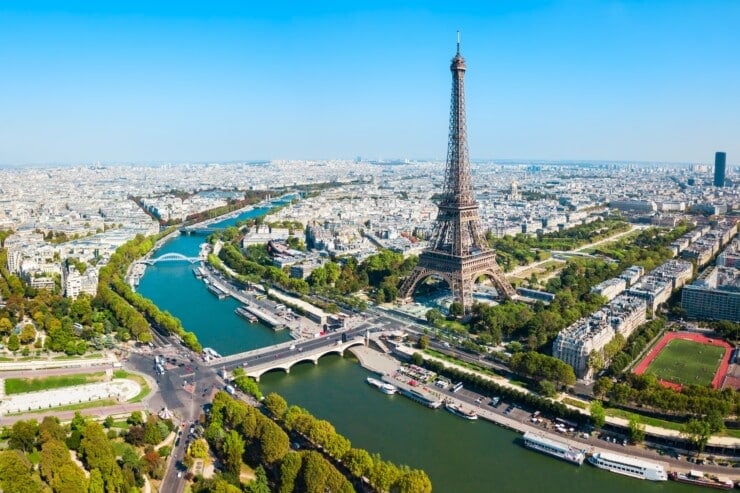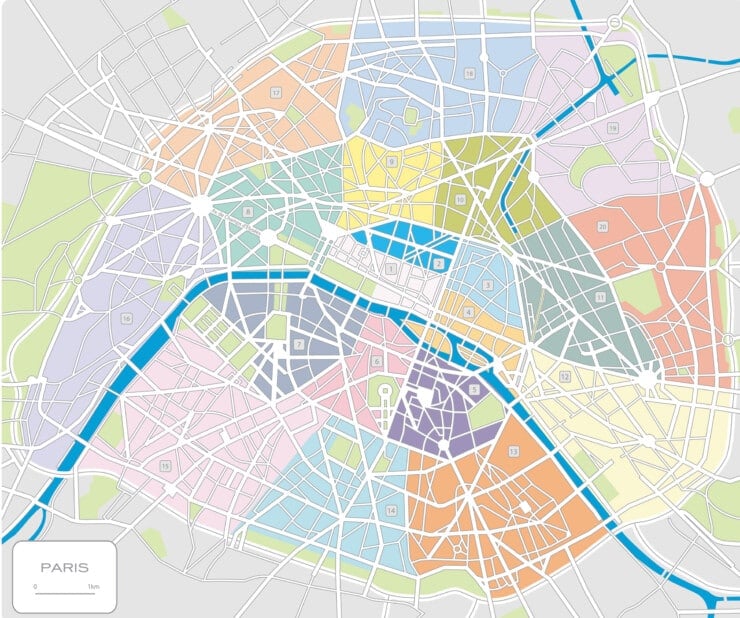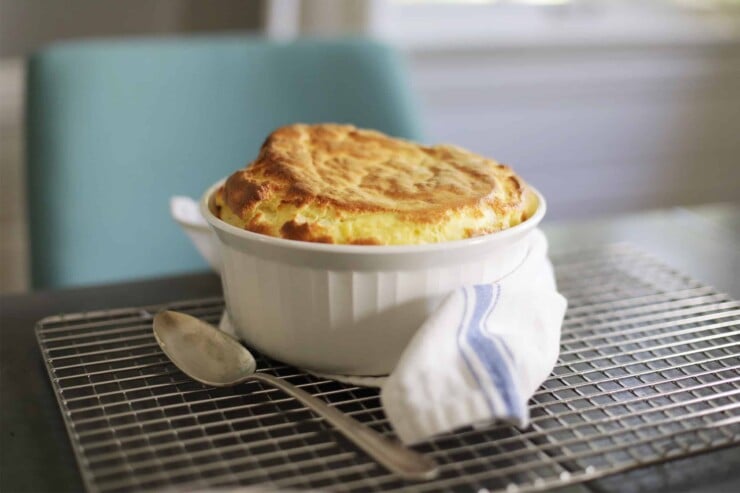Paris, the City of Lights, is a dream destination with rich history, stunning architecture, world-renowned art, and a vibrant creative scene. But, when planning a trip, our travel clients constantly ask: What is the best arrondissement to stay in Paris? This guide will help you navigate the city center’s different arrondissements (or neighborhoods).

Key Takeaways
- For first time visitors, the 1st through 7th arrondissements are recommended for their proximity to major attractions.
- Our travel clients' love staying in the Marais for its central location and quaint vibes.
- The ideal arrondissement depends on your personal preferences, be it vintage shopping, local art scenes, or central locations.
Deciding on the best arrondissement to stay in Paris is subjective. It depends on whether you want to live like a local or be in an up-and-coming area. For first-time visitors, a few of Paris’ arrondissements (the 1st through 7th) are more centrally located and closer to main attractions like Notre Dame Cathedral, Place Vendôme, or museums like the Centre Pompidou.
As someone who has lived in the French capital, has a French family, and has been there countless times, I have first-hand knowledge of the best arrondissement to stay in Paris. From my first trip to Paris over 20 years ago, when I stayed near Chinatown, to my culinary school-era apartment in the shadow of Sacré Coeur, I’ve spent years exploring the city. Like New York, there is a quartier for every interest: vintage shopping, hanging with local artists, or being smack-dab in the city center.
As a travel planner who curates custom French travel itineraries, I help our clients find the best places to stay, whether it’s their first time or their 20th visit.

The Best Arrondissement To Stay In Paris
Paris neighborhoods are divided into 20 districts (known as “arrondissements” or “arrd.” for short), each with a distinctive character. They are arranged like snail shells and spiral out from the city center, with the Seine River splitting the city into the Right Bank (north bank) and the Rive Gauche (Left Bank). The arrondissement number is often shown in Roman numerals on street signs and is the last two digits of the postal code (so 75008 is for addresses in the 8th).
Though these arrondissements demarcate the official neighborhoods, locals often refer to an area by its closest monument (Bastille, Louvre) or metro station (Anvers, Rivoli). Adding to the confusion, mini neighborhoods, like the Latin Quarter, Marais, Bercy, or SoPi, are within each arrondissement.
Our travel clients consider the best arrondissement to stay in Paris as the 1st, 3rd, 4th, 7th, 9th, 10th, and 18th. However, they stay on specific streets to avoid traffic, crowds, or dodgy areas. Deciding which Paris neighborhood is best for staying depends on your interests, budget, and travel style. You’ll want to weigh the benefits of being a short walk to your favorite place versus dealing with crowds or traffic.
Here is a breakdown of some of the most interesting neighborhoods to help you decide the best arrondissement to stay in Paris.

1st Arrondissement: The Heart of Paris
The 1st arrondissement is often ranked as the best arrondissement to stay in Paris for first-time visitors. That’s because it’s central and follows the river from the Louvre to the Arc de Triomphe along the Axe Historique or the historic Axis. It is home to the government and some of Paris’ most iconic landmarks, like the Tuileries Gardens, Place de La Concorde, and the Palais Royal.
Staying here puts you close to major sights, the river, and high-end shopping streets like Rue Saint Honoré. It also allows you to be in the heart of Paris with easy access to metro stations and walking distance to many attractions. While it is central and feels the most like a scene from “Emily in Paris,” this neighborhood is not our favorite because it can be touristy.
Pros: Very central and has a mix of shopping, parks, history, and sites
Cons: The hotels here are costly, and the area can feel touristy
Best for: Those who want a stereotypical Paris experience with parks, high-end shopping, and luxe cafes
Classic Hotel: Hoxton Paris
2nd Arrondissement: Les Halles
The 2nd is the smallest arrondissement in Paris and is known as Les Halles for the historic market that once stood there. It features bustling boulevards and a plethora of shops and restaurants. Rue Montorgueil is a vibrant street filled with cafes, bakeries, and boutiques, making it an excellent choice for food lovers looking to try the most famous foods in France and shoppers.
If a central location is key for your trip, you’ll want to consider staying in the 1st or 2nd arrondissement. However, the 2nd doesn’t top our list as the best arrondissement to stay in Paris because it feels more commercial than other areas. Also, big streets chop up the layout, making it less intimate than other parts of Paris.
Pros: It is a very central and convenient part of the city
Cons: The boulevards and chain stores make it less quaint than other areas
Best for: A budget traveler who wants to be central but doesn’t care to explore the immediate neighborhood
Classic Hotel: Adèle & Jules

3rd and 4th Arrondissements: Le Marais and The Islands
Many of our travel clients stay in the 3rd and 4th arrondissements. Thanks to the charming streets, boutique hotels, and great shopping, they consider this area the best arrondissement to stay in Paris. The two areas are often mentioned together because the historic area known as Le Marais spans both neighborhoods. Le Marais is the belle of the Parisian neighborhood ball, as it has it all: quaint landmark streets, art galleries, world-class shopping, and a vibrant LGBTQIA+ scene.
It’s home to the Place des Vosges, the oldest planned square in Paris, the Marché des Enfants Rouges, the oldest food market in Paris (and where I had the best version of a Jambon Beurre ever), and renowned museums like the Centre Pompidou, the Musée Picasso, and the Musée Carnavalet. It is also one of the few areas in Paris where shops and restaurants are open on Sundays.
The 4th arrondissement is also home to the inner-city islands of Île de la cité and Île Saint-Louis, the city’s geographic center and where Paris was founded. Landmarks like the Notre Dame de Paris cathedral, La Sainte-Chapelle, the Conciergerie, and the lovely Elizabeth II flower market are on these islands. It is also home to Berthillon, the ice cream shop that is arguably the first place to have created salted caramel ice cream!
Pros: A vibrant area with historic buildings, excellent museums, and boutiques
Cons: It can get busy, especially on Sundays when it’s one of the only neighborhoods that is open
Best for: Solo travelers or couples who want to stay in boutique hotels and shop, yet still be able to walk to major sites.
Classic Hotel: Pavillon De La Reine

5th and 6th Arrondissement: Latin Quarter and St-Germain-des-Prés
The Latin Quarter (5th arrondissement) and St-Germain-des-Prés (6th arrondissement) are synonymous with the city’s intellectual and artistic heritage. The Latin Quarter is home to the Sorbonne University, the Pantheon, and Rue Mouffetard, a lively street with markets and cafes.
St-Germain-des-Prés boasts famous historic cafes, like Café de Flore (where you can eat classic French food), the Jardin du Luxembourg, and many antique shops. There are also many world-class bakeries and pastry shops here, like the original Paris location of the renowned Pierre Hermé.
Both neighborhoods offer a charming, bohemian vibe with plenty of culture, and check the box on what many visitors think of when they dream of Paris. Literary buffs, antique collectors, and film lovers are drawn to this part of the city, as classic writers like Jean-Paul Sartre and Hemingway frequented it. It’s featured in many French films, including Breathless, Charade, and The Dreamers.
My take on this area is that some parts are charming, quiet, and chic, while others have many bars and a noisy nightlife. They are not the top of our list of the best arrondissements to stay in Paris since they can feel touristy. You have to know which streets are best for lodging, and if you have questions, contact us so we can help you weigh in on that matter.
Pros: Very central, so that you can access a lot of the city
Cons: It is a very popular area, so it can get touristy
Best for: Parents of students or families with kids (or students studying abroad at La Sorbonne) since you have lots of mid-priced cafes and great parks
Classic Hotel: Relais Christine
7th Arrondissement: Eiffel Tower and Musée D’Orsay
The 7th arrondissement is mainly residential but includes some of Paris’ most famous landmarks, including the Eiffel Tower, the Champ de Mars Park, the Musée Rodin, the Musée du quai Branly, the Musée d’Orsay, and Les Invalides. This area is one of the best arrondissements to stay in Paris if you are after a quieter, more upscale atmosphere with beautiful streets and luxury hotels.
It’s ideal for those looking for a serene stay with a view of the Iron Lady while also exploring gems like the food street that is Rue Cler (don’t miss the incredible cheese shop, Marie Anne Catin) or the impressive military museum known as the Musée de l’Armée. I lived in this neighborhood for a year and liked how many parks and museums there are. However, if it is your first time in Paris, it could feel too quiet as it doesn’t have the touristy nightlife of other areas.
Pros: In the mix without being super touristy
Cons: You want to stay in one part to access the city, but still easily access other areas
Best for: Travelers who want to be near the action but not in it
Classic Hotel: Le Walt
8th Arrondissement: Champs-Elysées and Arc de Triomphe
The 8th arrondissement is all about luxury. It is where you’ll find the Champs-Elysées, the Arc de Triomphe, the Grand Palais, and the Golden Triangle, an area known for high-end shopping and the city’s best luxury hotels.
This neighborhood is the best arrondissement to stay in Paris for those looking to indulge and experience the city’s glamorous side. Even if you don’t stay here, it’s a great area to pull up to a cafe and people-watch as you sip a glass of wine or a Citron Presse (French Lemonade). While this arrondissement oozes luxury, some lodging is too pricey and doesn’t feel like a good value.
Pros: One of the most beautiful parts of the city, yet very central
Cons: It is a posh area, so some of the businesses and people can feel a bit snobby
Best for: High-end travelers who are focused on staying at 5-star luxury hotels
Classic Hotel: George V
9th Arrondissement: Les Grands Magasins and Pigalle
There are two sides to the 9th arrondissement: a shopping district with wide streets and a vibrant neighborhood with local stores and nightlife. Between the Gare Saint-Lazare and the area of Boulevard Haussmann, you’ll find some of the most historic grands magasins or department stores like Galeries Lafayette and Printemps.
A bit east of that is Pigalle, known for its nightlife, with venues like the Moulin Rouge and numerous jazz clubs. The area has a gritty, independent spirit with a great selection of bars, cafes, and live music venues. South Pigalle, or SoPi, is becoming increasingly popular for its trendy boutiques and vibrant atmosphere. It is home to some of the best bars in the city, such as The Little Red Door.
We send many clients to this neighborhood if they have been to Paris and want to be in a buzzier area with more nightlife. Like the Left Bank, you need to know which streets to stay on because some feel gritty while others are quaint.
Pros: One of the most up-and-coming parts of the city center
Cons: Parts are the old red light district and can feel a bit lowbrow
Best for: Young travelers and couples who want to be around live music venues and some of the city’s best bars
Classic Hotel: Le Pigalle

10th, 11th, and 12th Arrondissement: Canal Saint-Martin and Bastille
Any of these areas can be the best arrondissement in Paris for those after a more laid-back, hipster vibe. The Canal Saint-Martin (10th arrondissement) is popular for picnics and strolls. The 11th arrondissement is home to the Bastille, known for its lively nightlife and diverse dining. The 12th arrondissement features the expansive Bois de Vincennes, a large park perfect for outdoor activities.
It should be said that these neighborhoods have better and worse places to stay. The most central and liveliest parts are around the canal and down to the Bastille. It’s a significant part of the city since it’s near the Gare du Nord, Gare de l’Est, or Gare de Lyon train stations and provides easy access to some of the most classic day trips from Paris.
Our travel clients who live in Brooklyn, LA’s Silverlake, or the Bay Area’s Mission district tend to like the nightlife and young spirit here. However, we wouldn’t recommend staying close to the train stations, as the areas can get dodgy.
Pros: One of the most vibrant and creative parts of the city
Cons: Not a lot is on the river, and, depending on where you are,it can feel a bit removed from the rest of the city
Best for: Young travelers and couples who want to be near nightlife
Classic Hotel: Le Petit Oberkampf
13th, 14th, and 15th Arrondissement: Off the Beaten Path
The 13th arrondissement is known for its large Chinatown and the striking Bibliothèque François Mitterrand. The 14th arrondissement houses the catacombs and offers a quieter, more residential feel. The 15th arrondissement is a residential area with a local vibe, making it a great place to experience everyday Parisian life.
If you are going to stay in these neighborhoods, we suggest you stay away from the Paris Austerlitz train station and the nearby hospital, as they are not very quaint. Instead, stay west or south of the Jardin des Plantes so that you’re on the border of the 5th arrondissement and can easily access significant sites.
Pros: One of the more diverse areas of the city
Cons: If you stay too far south, you’ll feel removed from the rest of the city.
Best for: Budget travelers who are looking to be near the action but not in it
Classic Hotel: Hotel Le Six
16th Arrondissement: High-End Residential
The 16th arrondissement is a high-end residential area with beautiful streets and luxury homes. It may not have as many tourist attractions, but it offers a peaceful and elegant setting.
We consider it hte best arrondissement in Paris for those looking for a more refined and quiet stay. The most famous site is the Jardins du Trocadéro, which provides what many consider the best view of the Eiffel Tower. Not many of our clients stay here; it can feel too quiet and far from the city’s major sites.
Pros: If you want to stay here, look for lodging on the edge of the 8th and in the general area of the Trocardéro so that you can more easily access major sites
Cons: It’s on the higher end, so everything is pricier
Best for: Luxury travelers who have been to Paris before
Classic Hotel: Shangri-La Paris
17th Arrondissement: Local Vibes
The 17th arrondissement is primarily residential and doesn’t have many tourist attractions. However, this neighborhood is sandwiched between the 9th, 18th, and 8th arrondissements to provide access to those neighborhoods’ sites without crowds or craziness.
Some clients like to stay here to quickly access those other arrondissements without dealing with loud nightlife. However, we would not recommend staying near Gare Saint-Lazare as it can be noisy and feel less quaint.
Pros: Can be quiet and more residential, but still has lovely shops
Cons: It is divided by Gare Saint-Lazare, so it’s not the most walkable
Best for: Those who want access to the 18th and the 9th, but at a better value
Classic Hotel: Eldorado

18th Arrondissement: Montmartre and Sacré-Cœur
The 18th arrondissement is centered around the charming hilltop Montmartre (“La Butte”), a former artists’ village once frequented by Picasso and Dali and home to the imposing Sacré-Cœur Basilica.
It’s a bohemian neighborhood with narrow streets, lively cafes, and vibrant markets. Home to some of our favorite French crepe spots, it is best known for its cobblestoned streets, the basilica, the famous Rue Lepic, and the lovely cemetery. A bonus is that it’s close to the famed flea market, Saint-Ouen, making it ideal for vintage lovers.
Montmartre is one of the best neighborhoods in which to experience Paris’s artistic spirit, and the sides facing the city also have lovely views of Paris. I loved staying here because the locals were friendly and welcoming. It almost feels like a village, so it can make this big city feel smaller. However, you’ll want to be careful where you stay, as some areas feel remote from the rest of the city, while the area toward Gare du Nord can get dicey.
Pros: Lots of lovely cobblestoned streets and views back on the city center
Cons: The major sites like the Place du Tertre can get busy in high season
Best for: Travelers who like boutique hotels and want a village feel within a big city
Classic Hotel: Hotel Particulier Montmartre
19th and 20th Arrondissement: Belleville and Père Lachaise Cemetery
The 19th and 20th arrondissements are up-and-coming areas with a gritty yet vibrant atmosphere. Belleville (20th arrondissement) is known for its street art, multicultural vibe, and the famous Père Lachaise Cemetery, where notable figures like Oscar Wilde and Jim Morrison are buried.
These neighborhoods are farther afield, so they may make you feel out of touch with the city’s heart, but the lodging is more affordable and offers a more authentic and local experience.
Pros: Has a younger, more modern feel
Cons: Rather far from major sites
Best for: Young, budget-conscious travelers who don’t mind riding the metro often or want to soak up the local neighborhood.
Classic Hotel: Mama Shelter Paris Est

Right Bank Versus Left Bank
Understanding the Right and Left Bank is essential for first-time visitors to Paris. The Right Bank (Rive Droite) is north of the Seine River, while the Left Bank (Rive Gauche) is to the south. These distinctions are geographic and cultural. The Left Bank was the center of boho life in the early 20th century, while the Right Bank (along the river) was historically swankier and posher.
Right Bank
The Right Bank is home to classic sites like the Louvre Museum, the Champs-Élysées, and the seat of government. Traditionally considered the more proper side of the river, it has evolved into a mix of bohemian and upscale areas. Neighborhoods like Le Marais (3rd and 4th arrondissements), Pigalle (9th arrondissement), and Montmartre (18th arrondissement) offer a unique blend of history, culture, and nightlife.
Left Bank
The Left Bank is known for landmarks like the Eiffel Tower, the Musée d’Orsay, and the Sorbonne University. Historically, it was the intellectual center for expatriates like Hemingway and Fitzgerald. Today, it features everything from high-end boutiques in St-Germain-des-Prés to the gardens of Jardin du Luxembourg.

Practical Tips for Getting Around Paris
Now that you have decided on the best arrondissement to stay in Paris, here are tips to help you navigate the city:
Metro Stations
Paris has over 300 metro stations, which is the easiest way to get around. Look for stations with names of nearby landmarks or neighborhoods. This is the most efficient way to get to most parts of the city (aside from the suburbs or posh neighborhoods like the 16th, which don’t have as many stops).
Walking
Many attractions are within walking distance of each other, especially in central Paris. Walking is a great way to explore the city and discover hidden gems. The older parts of the city (where roads are more circuitous) can get confusing, so remember you can find a city map on the side of public toilets or at the metro stops.
Biking
Paris has an extensive bike-sharing system called Vélib, a convenient and eco-friendly way to explore the city.
Bus and Tram
The bus and tram networks are extensive and can take you to areas not covered by the metro. However, there is major traffic in Paris, so bus travel can be very slow. And, since the tickets are non-transferable between the bus and the metro, it’s not the most convenient method of transport.
Taxi and Uber
Taxis can be hard to hail in Paris, and Uber is not as popular as it is in the United States. Also, because the city has a lot of traffic, traveling by car can be costly.
Choosing the best arrondissement to stay in Paris depends on your interests and what you want to experience. Whether you’re drawn to the historic charm of Le Marais, the Latin Quarter’s intellectual vibe, or Montmartre’s bohemian spirit, a neighborhood in Paris is perfect for you. Remember to consider proximity to major sights, accessibility to public transportation, and the overall atmosphere of the area. Paris is a city of endless possibilities, and staying in the right arrondissement can make your trip even more memorable.

Recipes Inspired By France
Not heading to France quite yet? Here are a few of our favorite classic French recipes to make at home to stoke your wanderlust:
Frequently Asked Questions About The Best Arrondissement To Stay In Paris
For first-time visitors, the 1st, 4th, 6th, and 7th arrondissements are highly recommended. These central districts are home to many of Paris's iconic attractions. The 1st arrondissement includes the Louvre and the Tuileries Gardens, making it ideal for culture and art lovers. The 4th arrondissement houses Notre Dame and the charming Marais neighborhood. The 6th is known for its literary history and cafes, while the 7th features the Eiffel Tower and the Musée d'Orsay.
The 18th arrondissement, particularly the Montmartre area, is considered one of the most romantic parts of Paris. With its quaint streets, stunning Basilica of Sacré-Cœur, and artists' square at Place du Tertre, Montmartre offers a charming and somewhat quieter setting. Additionally, the 5th arrondissement (the Latin Quarter) is also romantic with its historic streets, beautiful gardens, and proximity to the Seine River.
The 11th arrondissement is renowned for its vibrant dining scene and nightlife, making it a popular choice for foodies and those looking to experience Paris's contemporary culture. This district hosts a variety of trendy restaurants, bars, and clubs, particularly around Rue Oberkampf. Additionally, the nearby 3rd and 10th arrondissements also offer an abundance of dining options and lively atmospheres.
Get A Personalized Travel Itinerary

Famous Foods In Paris
Now that you’re dialed in on the best arrondissement to stay in Paris, here are the classic Parisian foods you’ll want to eat when you travel there. From the flaky layers of a perfect croissant to the rich depths of a classic coq au vin, this guide to the famous foods in Paris will teach you on the iconic dishes that define Parisian cuisine.

France Travel Guide
Thinking of traveling to France in real life? Check out our free France Travel Guide for our best travel tips, recipes, and articles on France.
Have Us Plan Your France Trip
Did you know we’re also a boutique travel agency specializing in France travel planning? If you’re looking to plan one of the best trips to France, our France trip planner services are here to help you plan your perfect itinerary.
Photo Credit: Paris aerial photo by saiko3p; Paris map by AKaiser; Paris 1st photo by D.Bond; Paris Marais photo by olrat; Paris canals photo by Page Light Studios; Montmartre photo by Songquan Deng; Paris river bank photo by JeanLucIchard; Paris metro photo by Steven Hodel